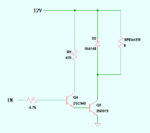abuhafss
Full Member level 2
Hi
Attached is a circuit of car siren which produces ear piercing sound when powered on.
I am interested in the amplifier section of the circuit which is simple and cheap. I need to amplify simple tones with frequencies less than 1kHz. I tried the circuit as shown attached but wasn't successful. Any suggestions to make the circuit work shall be appreciated.
Attached is a circuit of car siren which produces ear piercing sound when powered on.
I am interested in the amplifier section of the circuit which is simple and cheap. I need to amplify simple tones with frequencies less than 1kHz. I tried the circuit as shown attached but wasn't successful. Any suggestions to make the circuit work shall be appreciated.

